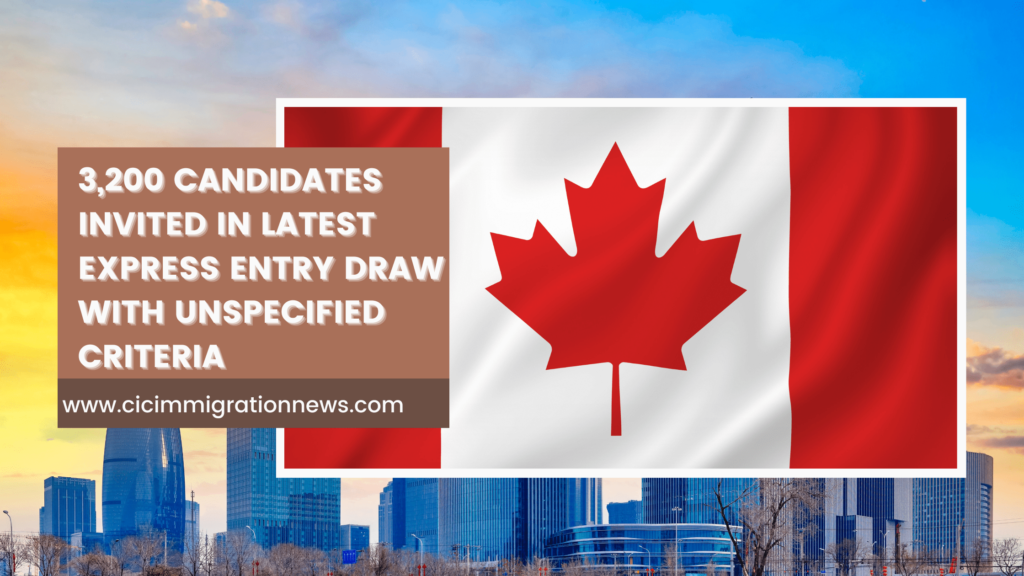3,200 Candidates Invited in Latest Express Entry Draw with Unspecified Criteria On September 19th, 2023, at 15:04:11 UTC, Immigration, Refugees, and Citizenship Canada (IRCC) carried out its 263rd Canada Express Entry draw. This event was all about inviting potential immigrants who are interested in getting a Canadian PR visa through the Express Entry system. It’s worth noting that this draw wasn’t focused on a particular immigration program.
In this recent draw, which is number 263, a total of 3,200 skilled applicants were selected from the group of people who already have active Express Entry profiles. These folks could belong to any of three Canada Express Entry categories:
1. Federal Skilled Worker Program (FSWP)
2. Federal Skilled Trade Program (FSTP)
3. Canadian Experience Class (CEC)
As of September 19th, 2023, IRCC reported that 216,035 immigrants had successfully submitted their profiles. The way they picked these folks was based on something called the Comprehensive Ranking System (CRS) score. Out of all these immigrants, the most significant chunk, which is 58,838 individuals, had a CRS score ranging from 451 to 500. Moreover, 3,091 immigrants had a CRS score between 501 and 600, while 2,637 applicants scored between 601 and 1200 on the CRS scale.
Understanding the Canada Express Entry system involves paying attention to specific details. These details include the total number of invitations sent, the date of the draw, and the minimum Comprehensive Ranking System (CRS) score required.
In the recent draw, a total of 3,200 invitations were issued on September 19th, 2023, at 15:04:11 UTC. To be eligible for consideration, candidates needed a minimum CRS score of 531. Additionally, there was a tie-breaking rule in place, where candidates with a score of 531 or higher who submitted their profiles before September 12th, 2023, at 12:16:31 UTC, were selected.
Now, let’s break down how you can apply for Canada’s Express Entry system, which streamlines immigration for the Federal Skilled Worker Program (FSWP), the Federal Skilled Trades Program (FSTP), and the Canadian Experience Class (CEC).
Firstly, you need to create an Express Entry profile. This involves providing details about your education, work experience, language skills, and more. Your profile will be assigned a CRS score based on these factors.
Next, you’ll enter a pool of candidates. Your CRS score determines your rank in this pool. Periodically, the Canadian government conducts draws, like the one mentioned earlier, to invite candidates with the highest CRS scores to apply for permanent residency.
If you receive an invitation, you have a limited time to apply for permanent residency. This typically involves submitting documents to prove the information in your profile is accurate.
Once your application is approved, you’ll receive a Confirmation of Permanent Residence (COPR) and can then make plans to move to Canada. It’s a simplified process designed to attract skilled workers and help them become permanent residents of Canada.
Step 1:
To start the Canadian immigration process, you first need to check your eligibility. The eligibility criteria vary depending on the specific program you’re interested in.
If you’re considering the Federal Skilled Worker Program (FSWP), ensure that you’ve got at least one year of continuous full-time work experience (or its part-time equivalent) in a skilled occupation categorized as NOC skill level 0, A, or B within the last ten years. You also need to meet the minimum language requirements and show that you have enough settlement funds.
For those interested in the Federal Skilled Trades Program (FSTP), you’ll need to confirm that you possess at least two years of full-time work experience (or its equivalent part-time) in a skilled trade within the past five years. Additionally, you must either secure a valid job offer or certification in your trade from a Canadian authority.
If the Canadian Experience Class (CEC) is more your speed, make sure you have one year of skilled work experience in Canada within the past three years and meet the language requirements for your job.
Step 2:
After checking your eligibility, it’s time to prove your language proficiency. You’ll need to undergo an approved language test in either English or French, which is recognized by the Immigration, Refugees, and Citizenship Canada (IRCC). Your performance on this test will affect your Comprehensive Ranking System (CRS) score, which plays a crucial role in your immigration process.
Step 3:
If you’re applying under the Federal Skilled Worker Program (FSWP), you should have your foreign educational qualifications assessed. This involves obtaining an Educational Credential Assessment (ECA) report.
Step 4:
Once you’ve cleared the language proficiency and educational qualifications hurdles, eligible candidates must create an online Express Entry profile. This profile will require you to provide detailed information about your work history, education, language skills, and more.
Step 5:
Your Comprehensive Ranking System (CRS) score is determined based on various factors, including your age, education, work experience, and language proficiency. This score helps assess your potential for immigration success.
Step 6:
Periodically, the IRCC conducts Express Entry draws. In these draws, they issue Invitations to Apply (ITAs) to candidates with the highest CRS scores in the pool. If you receive an ITA, it means you can apply for permanent residency in Canada, marking a significant step in your immigration journey.
In Step 7
of the immigration process, once you’ve received an Invitation to Apply (ITA), you’ve got 60 days to gather all the necessary documents and pay the required fees for your permanent residency application.
Moving on to Step 8
Both you and your family members, if applicable, will need to go through medical check-ups and security background checks as part of the application procedure. This helps ensure that everyone entering Canada is healthy and poses no security risks.
Finally, in Step 9
After your application has been reviewed and approved, you’ll get a document called a Confirmation of Permanent Residence (COPR). It’s crucial to remember that you must enter Canada before the COPR’s expiration date, which is usually stated on the document. This COPR is the final step that confirms your permanent residency in Canada. So, make sure to keep an eye on that expiration date and plan your move accordingly.



